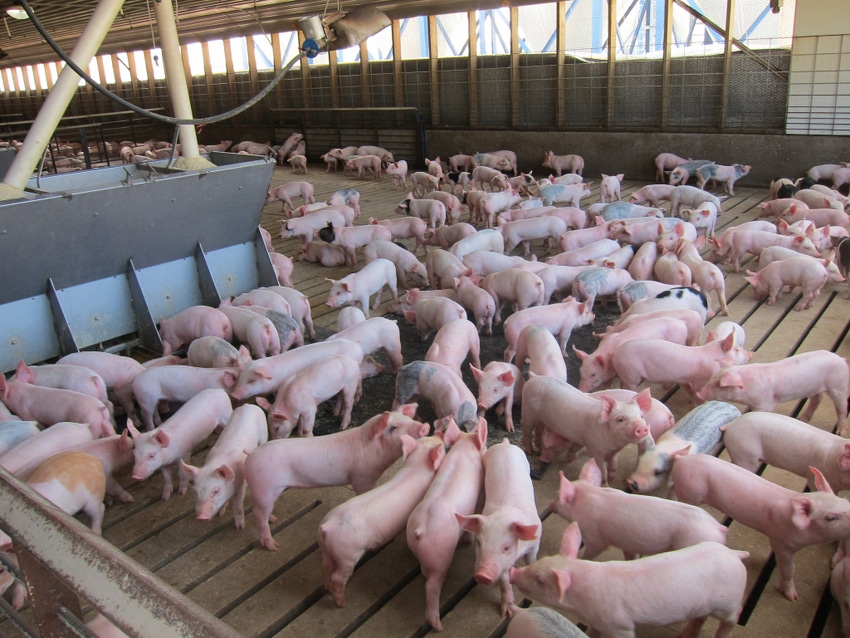High-fiber and the enzymatic addition to high-fiber diets, have an effect over the local immune response of the gut: while high-fiber diets promote an anti-inflammatory status, the supplementation with carbohydrases seems to change this response and induce a pro-inflammatory profile in the distal intestine of pigs.
March 14, 2017

By Marta Ferrandis Vila, Zhikai Zeng, Gerald C. Shurson and Milena Saqui-Salces, University of Minnesota Department of Animal Science; and Pedro E. Urriola, University of Minnesota Department of Animal Science and Department of Veterinary Population Medicine
Feed ingredient costs have increased during the last 10 years (Woyengo et al., 2014) while the amount of feed or energy per pound of carcass weight in growing-finishing pigs have not changed over time (Annual Report of the National Pork Board Animal Science Committee, 2012). In order to reduce feed costs, the use of high-fiber ingredients such as corn dried distiller’s grains with solubles and wheat middlings has become a common practice among swine farmers. However, caloric efficiency and growth of pigs fed high-fiber feed ingredients is usually less than pigs fed corn-soybean meal diets (Noblet and Goff, 2001; Wu et al., 2016).
Supplementation of pig high-fiber diets with fiber-degrading enzymes is an approach to increase energy and amino acid digestibility (Zijlstra et al., 2010) that may result in a more cost-effective production method. Different components of fiber will modify the intestinal microbiome and microbial metabolites, likely leading to changes in the intestinal immune response that can in turn affect the whole body’s immune response (Kuo, 2013). However, it is not known whether the addition of fiber-degrading enzymes can alter the immune response triggered by fiber in the diet.
Our group recently measured the changes in some markers of the immune response (cytokines and interleukins) in the distal intestine of pigs fed high-fiber diets with and without enzyme supplementation. We compared levels of different cytokines and interleukins in the intestine of finisher pigs fed a standard corn-soybean meal-based diet, a high-fiber DDGS diet (40% DDGS inclusion) and a high-fiber WM diet (30% WM inclusion), and pigs fed these same last three diets supplemented with a carbohydrase cocktail composed by 100 milligrams per kilogram of 1,500 U/g xylanase, 1,100 U/g beta-glucanase, 110 U/g mannanse and 35 U/g galactosidase.
Concentrations of pro-inflammatory cytokines were increased in pigs fed high-fiber diets supplemented with carbohydrases. Some of the changes observed were on interferon gamma that showed a 50% increase in colon, while interleukin 1 beta had a 46% increase in the ileums of those animals fed high-fiber diets with enzymatic supplementation when compared to the pigs fed the same high-fiber diets without enzymes. The high-fiber diets induced more anti-inflammatory cytokines when compared with the enzyme-supplemented diets. Interleukin 4 concentration was 32% higher in the ileum of pigs fed the WM diet when compared to the levels in animals fed any of the diets supplemented with carbohydrases. Interleukin 11 levels decreased 62% in ileum and colon of pigs fed high-fiber diets after the carbohydrase enzyme mix was added.
In summary, our results show that both, the high-fiber and the enzymatic addition to those high-fiber diets, have an effect over the local immune response of the gut: while high-fiber diets promote an anti-inflammatory status, the supplementation with carbohydrases seems to change this response and induce a pro-inflammatory profile in the distal intestine of pigs. It is important to notice that these results were not the same for the ileum and colon, probably caused by the different microbial communities in these two sites and the modulation of these communities by the diet.
The immunomodulatory effect that we have observed triggered by high-fiber diets and enzyme supplementation may be a potential tool to fight certain infections. However, more research is needed in order to elucidate the mechanisms involved in this immune modulation and how to use high-fiber diets to promote animal health in production systems.
References
Annual Report of the National Pork Board Animal Science Committee. 2012. :32.
Kuo, S. 2013. The Interplay Between Fiber and the Intestinal Microbiome in the Inflammatory Response. Av. Nutr.:16–28. doi: 10.3945/an.112.003046.16
Noblet, J., and G. Le Goff. 2001. Effect of dietary fiber on the energy value of feeds for pigs. Anim. Feed Sci. Technol. 90:35–52.
Woyengo, T. A., E. Beltranena, and R. T. Zijlstra. 2014. Nonruminant Nutrition Symposium: Controlling feed cost by including alternative ingredients into pig diets: A review. J. Anim. Sci. 92:1293–1305. doi: 10.2527/jas.2013-7169
Wu, F., L. J. Johnston, P. E. Urriola, A. M. Hilbrands, and G. C. Shurson. 2016. Effects of feeding diets containing distillers’ dried grains with solubles and wheat middlings with equal predicted dietary net energy on growth performance and carcass composition of growing – finishing pigs 1. :144–154. doi: 10.2527/jas2015-9592
Zijlstra, R. T., A. Owusu-asiedu, and P. H. Simmins. 2010. Future of NSP-degrading enzymes to improve nutrient utilization of co-products and gut health in pigs ☆. Livest. Sci. 134:255–257. doi: 10.1016/j.livsci.2010.07.017
You May Also Like



